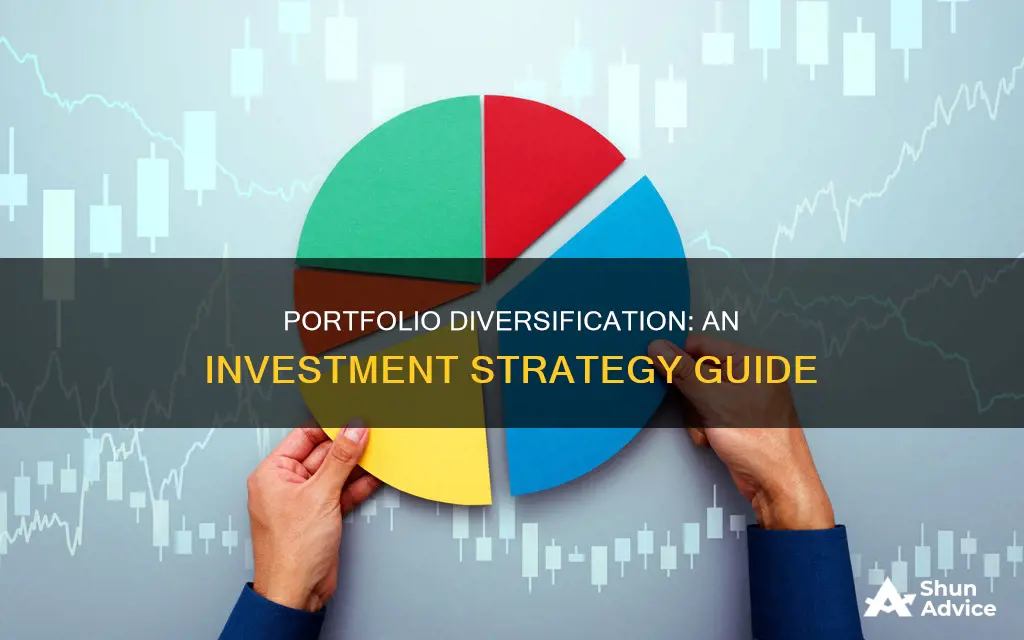
Portfolio diversification is a risk management strategy that blends different investments in a single portfolio. It is the practice of spreading investments across various asset classes, industries, and geographical locations to limit exposure to any single asset or risk. Diversification aims to reduce the volatility of a portfolio over time and mitigate unsystematic risks, such as business, financial, operational, and regulatory risks. It is important to note that diversification does not guarantee returns or protect against all losses, especially from systematic risks like inflation, interest rates, or geopolitical events.
| Characteristics | Values |
|---|---|
| Purpose | Reduce risk, enhance and preserve portfolio value |
| Risk reduction | Reduce volatility, permanent loss of capital, and unsystematic risk |
| Returns | Potentially higher long-term returns, lower short-term |
| Investment types | Stocks, bonds, real estate, commodities, cash, ETFs, mutual funds, REITs, cryptocurrencies |
| Investment locations | Domestic and international |
| Investor experience | May be overwhelming for newer, inexperienced investors |
| Investor considerations | Risk tolerance, time horizon, age, financial goals, and circumstances |
What You'll Learn

Diversification reduces risk
Diversification is a risk management strategy that blends different investments within a portfolio. It is based on the idea that you should never put "all your eggs in one basket". By spreading investments across various industries, asset classes, and markets, investors can reduce their exposure to any single asset or risk.
Diversification aims to reduce the volatility of a portfolio over time. The positive performance of some investments can neutralise the negative performance of others. For example, if the price of oil falls, energy stocks may see their share prices fall. However, if you have also invested in other industries, the decline in value will have less of an impact on your portfolio.
It is important to note that diversification does not guarantee returns or protect against losses. Systematic risks, such as inflation, interest rates, or geopolitical events, can impact the broader economy and market as a whole.
- Diversify across asset classes: Invest in a mix of stocks, bonds, real estate, commodities, and cash and cash equivalents. Diversified portfolios generally contain at least two asset classes.
- Diversify within asset classes: For example, if you invest in energy stocks, consider adding tech, biotech, utility, and retail sectors to your portfolio. For bonds, look for different maturities and issuers.
- Diversify by location: Include foreign stocks and bonds in your portfolio to reduce exposure to country-specific risks.
- Explore alternative investments: Consider real estate investment trusts (REITs) and commodities, which are not strongly correlated with stocks or bonds.
- Rebalance your portfolio regularly: Even a diversified portfolio needs to be rebalanced to maintain an appropriate risk level.
- Consider your risk tolerance: Your risk tolerance will impact your approach to diversification. Aggressive investors with a higher risk tolerance may allocate more of their portfolio to stocks, while conservative investors may opt for a more balanced mix of stocks and bonds.
By diversifying your portfolio, you can reduce the risk of a cracked nest egg. While it may potentially cut into your return potential, diversification also reduces volatility and the likelihood of a permanent loss of capital.
Savings: Exploring Investment Options Beyond Fixed Deposits
You may want to see also

Diversify across asset classes
Diversification is a risk management strategy that mixes a wide variety of investments within a portfolio to reduce portfolio risk. Diversification is most commonly achieved by investing in different asset classes such as stocks, bonds, real estate, or cryptocurrency.
Diversification Across Asset Classes
The three main general asset classes in an investment portfolio are stocks, bonds, and cash or cash equivalents. Stocks allow investors to own a piece of a company and offer the highest long-term gains, but they are volatile, especially in a cooling economy. Bonds pay interest to investors who lend money to a company or government and are income generators with modest returns, but they are usually weaker during an expanding economy. Generally, bonds have an inverse relationship with stocks. Cash is low on both risk and return counts and can buffer volatility or unexpected expenses.
Other asset classes include commodities (such as precious metals) and alternative investments, such as cryptocurrency. These asset classes usually have a lower correlation to the stock market and can be effective in diversification.
Diversification Within Asset Classes
Investors can further diversify their portfolios by breaking down the above categories by factors such as industry, company size, creditworthiness, geography, investing strategy, bond issuer, and style.
Diversification Within Stocks
The economic cycle affects each business and respective stock differently, so intermingling companies operating in all kinds of industries is another way to reduce market risk. Some sectors are considered cyclical, where a company's fortune moves in sync with the economic cycle, such as consumer discretionary (clothing, electronics, cars, etc.), financial services, basic materials, and real estate. Some sectors are considered defensive, where the company's business is less impacted by the economic cycle, such as consumer staples (groceries, tobacco, etc.), utilities, and healthcare.
#### Size or Market Capitalization
Market cap is defined by the total value of a company's tradable stock (number of outstanding shares x price per share). Larger companies tend to be more stable and can weather economic downturns more easily, but they also tend to have less growth potential versus their smaller counterparts.
#### Style (Growth vs. Value)
Growth stocks are often expensive, but investors believe prices are justified due to high future growth potential. Value stocks are companies whose stocks are “on sale” or seem underpriced or undervalued.
Diversification Within Bonds
Bonds offer different levels of creditworthiness or safety, which corresponds with the bond's level of return. For instance, Treasurys are considered practically risk-free since it's unlikely the federal government will go bankrupt, which explains their relatively lower rate of return. Longer-term bonds receive higher returns because they are subject to more interest rate risk. Integrating bonds from various issuers can provide another level of diversification, such as the U.S. government, municipalities, and corporations.
Diversification Within Stocks and Bonds
Countries have varied economic cycles, so it makes sense to have exposure to both domestic and international markets. International or foreign markets are further classified as developed markets (more stable) and emerging markets (more volatile but with higher growth potential).
Benefits of Diversification
Portfolio diversification reduces overall risk while increasing the potential for overall return. That's because some assets will perform well while others do poorly, and their positions could be reversed in subsequent years. Over short-term periods, that return can vary widely. However, a well-diversified portfolio tends to earn the market's average long-term historic return. Owning a variety of assets minimizes the chances of any one asset hurting your portfolio. The trade-off is that you never fully capture the startling gains of a shooting star. The net effect of diversification is slow and steady performance and smoother returns, never moving up or down too quickly. That reduced volatility puts many investors at ease.
Investment Surpassing Savings: A Recipe for Economic Growth or Debt?
You may want to see also

Diversify within asset classes
Diversification is a risk management strategy that blends different investments within a portfolio. The idea is that a portfolio constructed of different kinds of assets will yield higher long-term returns and lower the risk of any individual holding or security.
Diversification can be achieved by investing in different asset classes, such as stocks, bonds, real estate, or cryptocurrency. It can also be achieved by purchasing investments in different countries, industries, company sizes, or term lengths for income-generating investments.
Diversify Your Stocks
When it comes to stocks, diversification increases when you own multiple stocks made up of different-sized companies (small, medium, and large companies), include different sectors (technology, consumer, healthcare, etc.), and are diversified geographically (domestic and international).
Diversify Your Bonds
If you're buying bonds, you might choose bonds from different issuers (federal government, state and local governments, and corporations) as well as those with different terms and credit ratings.
Diversify Your Real Estate Investments
Real estate investments can be diversified by investing in residential, commercial, or retail properties in different locations.
Diversify Your Exchange-Traded Funds (ETFs)
ETFs are a basket of securities that follow an index, commodity, or sector. You can diversify your ETFs by investing in a variety of underlying securities or commodities.
Diversify Your Commodities
Commodities are basic goods necessary for the production of other products or services. You can diversify your commodities by investing in a range of natural resources, such as oil, agricultural products, timber, or precious metals.
Diversify Your Cash and Short-Term Investments
Cash and short-term investments can be diversified by investing in treasury bills, certificates of deposit (CDs), money market vehicles, and other short-term, low-risk investments.
By diversifying within asset classes, you can further reduce your exposure to any one type of asset and lower the volatility of your portfolio over time.
Saving and Investing: Building Wealth and Security
You may want to see also

Diversify by location
Diversifying by location is an important aspect of a portfolio diversification investment strategy. This means investing in securities from different countries, which can provide a hedge against country-specific risks. For example, if you only own stocks and bonds from companies in your home country, your portfolio is vulnerable to economic downturns or other risks specific to that country. By investing in foreign stocks and bonds, you can reduce this risk. Foreign investments are subject to different risks, such as foreign taxation, currency risks, and political and economic development. However, during periods when domestic stocks are underperforming, global markets may be doing better.
It's worth noting that foreign markets can be more volatile than domestic ones due to increased risks associated with foreign issuers, politics, regulations, and economic conditions. These risks are particularly significant for investments focused on a single country or region.
When diversifying by location, it's important to consider the correlation between the investments in your portfolio. Even if you own stocks and bonds from multiple countries, they may all move in the same direction if they are positively correlated. For example, high-yield bonds often have a positive correlation with stocks, so a portfolio made up of these investments is not well-diversified.
To truly diversify by location, look for investments with low or negative correlations so that if one type of security declines in value, the other tends to counteract it. This can smooth out the performance of your portfolio over time and provide more consistent returns.
Additionally, within each country, you can further diversify your investments by industry, market capitalisation, and company size. For example, you can invest in a mix of large-cap and small-cap stocks or a combination of growth and value stocks.
Savings or Investments: Open Economy, Open Question
You may want to see also

Explore alternative investments
Alternative investments are a key component of a strong, diversified portfolio. They are any investment other than stocks, bonds, and cash. These include:
- Hedge funds: These pool investor capital and invest across various securities to manage risk and outperform the market rate of return.
- Private equity: This involves investing capital in private companies, including venture capital, growth equity, and buyouts.
- Real estate: This involves investing in residential, commercial, or retail properties, either directly or through a real estate venture fund or investment trust.
- Debt investing: This involves investing in the debt of private companies, which can be distressed or healthy.
- Commodities: This strategy focuses on investing in natural resources like oil, agricultural products, or timber.
- Collectibles: This strategy involves purchasing items like rare wines, cars, or baseball cards with the intent to sell them when their value has increased.
- Structured products: These involve fixed-income markets and derivatives.
Alternative investments are beneficial because they tend to have a low correlation with traditional assets. This means that if the stock market performs poorly, some alternative investments may perform well. They also provide access to less efficient and unexplored market segments, allowing active managers to exploit market inefficiencies.
When considering alternative investments, it is important to evaluate time horizons and liquidity. Alternative investments typically have longer time horizons and are relatively illiquid compared to traditional investments. Additionally, it is crucial to assess the risks and potential threats associated with these investments. While they can help spread out risk, they also carry their own inherent risks that require diligent research and due diligence.
To effectively incorporate alternative investments, advisors and investors must stay informed about current market trends and understand the nuances of various alternative asset classes. It is also important to conduct thorough due diligence by evaluating the track records, strategies, fee structures, and historical performance of alternative investment managers. When introducing alternative investments, a gradual integration approach is prudent, starting with modest allocations and gradually increasing exposure based on risk profiles and investment objectives.
By understanding and incorporating alternative investments, investors can enhance their portfolio diversification, access untapped market segments, and potentially achieve higher returns. However, it is vital to remember that alternative investments carry their own risks and require careful research and due diligence.
Savings and Investments: Two Sides of the Same Coin
You may want to see also
Frequently asked questions
Portfolio diversification is a risk management strategy that blends different investments in a single portfolio. The idea is to never put all your eggs in one basket, reducing the risk of a single stock, industry, or investment option.
The benefits of diversification include reduced risk and volatility in your portfolio, as well as the potential for higher long-term returns. Diversification can also make investing more enjoyable as it encourages exploring different unique investments.
Diversification can be achieved by investing in different asset classes such as stocks, bonds, real estate, and cryptocurrency. It is also important to diversify across countries, industries, company sizes, and term lengths.







